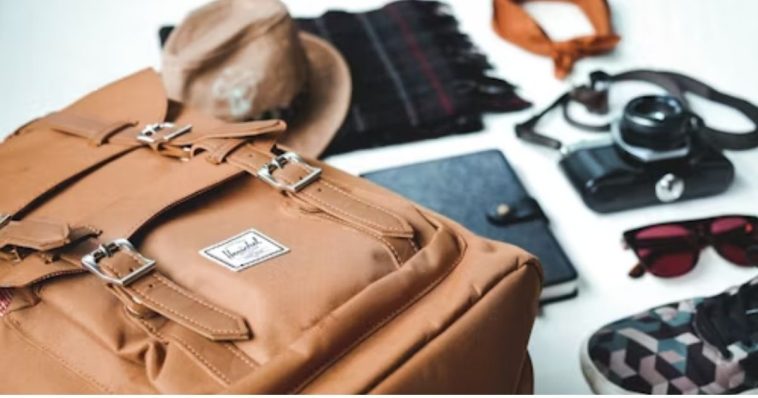Bags accompany daily routines and spontaneous escapes alike, enduring morning commutes, weekend plans, unpredictable weather, and frequent handling. With regular use comes gradual wear—surface grime, subtle stains, and structural fatigue. Like any essential wardrobe item, proper maintenance is key to preserving appearance, shape, and longevity. Leather, canvas, nylon, and vegan alternatives each require specific care techniques to maintain their distinct textures and finishes.
10 Smart Bag Care Tips to Keep Your Favorites Flawless
1. Know the Material First
Caring for a bag begins with understanding what it’s made of. Materials vary widely in texture, durability, and their response to cleaning methods—so treating each one appropriately is essential to preserving its quality.
- Leather, known for its luxurious feel and long-lasting wear, requires gentle handling. Regular conditioning helps prevent cracking, drying, and fading. A dedicated leather cleaner and conditioner applied with a soft cloth can maintain its luster over time.
- Canvas, recognized for its durability and casual appeal, tolerates light scrubbing. Spot cleaning is effectively achieved using a soft-bristle brush and mild soap diluted in water. To prevent shrinkage or distortion, drying must occur naturally, away from direct heat sources.
- Nylon and performance fabrics offer resilience and ease. These materials are often water-resistant and ideal for daily or travel use. A simple wipe-down with a damp cloth and gentle cleanser usually suffices. Most nylon bags dry quickly, making them low-maintenance and highly practical.
- Faux leather and vegan leather present a polished look but require special attention. These synthetic materials are prone to peeling if exposed to harsh chemicals. Use only non-abrasive cloths and alcohol-free cleansers. Conditioning sprays made specifically for vegan leather can help preserve flexibility and shine.
Regardless of the material, always begin by reviewing the manufacturer’s care instructions or internal label, especially before introducing any cleaning agents. A quick check can prevent irreversible damage and extend the lifespan of the bag.
2. Routine Cleaning Goes a Long Way
Consistent maintenance is the key to keeping bags looking fresh and refined—especially for those used on a daily basis.
- Start with weekly wipe-downs using a soft microfiber cloth or a dry brush. This simple habit removes surface dust and prevents buildup that can wear away at materials over time.
- For more thorough cleanings, mild soap diluted in warm water is effective for most materials. Avoid bleach, strong detergents, or harsh household cleaners, as they can strip finishes or alter textures. Use a soft, damp cloth to apply the solution with light, circular motions for even and gentle cleaning.
- Leather bags benefit from a two-step process: cleaning followed by conditioning. After the surface is cleaned, apply a leather conditioner with a lint-free cloth to keep the material supple and to protect it from environmental stressors like dry air or direct sunlight.
- Full submersion in water should be avoided, particularly for bags with structured shapes, metal hardware, or reinforced bases. Excess moisture can distort construction, compromise adhesives, and damage interior linings. Minimal water use remains the safest approach during cleaning.
3. Don’t Forget the Interior
While the exterior may draw the eye, the interior is where the real wear and tear happens. Spilled pens, makeup residue, crumbs, and dust accumulate over time—and neglecting the inside can lead to stains, odors, and a less enjoyable user experience.
- Begin by emptying all contents. Turn the lining inside out if possible, or use a small flashlight to spot hidden debris.
- To remove loose particles such as lint or dirt, effective tools include a lint roller, a handheld vacuum, or a soft-bristled brush. Particular attention should be given to corners and seams, where dust tends to accumulate undetected.
- For fabric linings, use a mild fabric-safe cleaner or a damp cloth with a touch of gentle soap to spot-treat any marks or stains. Avoid over-wetting the lining, and allow it to air dry completely before use to prevent mildew or unwanted odors.
- For leather-lined interiors, wipe with a slightly damp cloth and follow up with a dry one. Avoid soap or harsh solutions unless specifically approved for leather interiors.
For long-term upkeep, consider using pouches or bag organizers to minimize interior mess and protect delicate linings from everyday spills. These inserts also make it easier to switch bags while keeping essentials organized.
4. Store Smart
Proper storage is essential to maintaining the longevity, shape, and aesthetic appeal of any bag—especially during periods of non-use. Whether it’s a luxury investment or an everyday favorite, thoughtful storage helps prevent structural damage, color fading, and premature wear.
- Dust bags are ideal for protecting bags from environmental factors like dust, moisture, and accidental scratches. In their absence, cotton pillowcases offer a breathable alternative that shields without trapping humidity, unlike plastic covers, which can encourage mold and mildew.
- To maintain the bag’s shape, gently stuff the interior with acid-free tissue paper, soft scarves, or clean cloth. Avoid using newspaper, which can transfer ink, or overly rigid fillers that can stretch or misshape the bag over time.
- Store bags in a cool, dry location, away from direct sunlight, radiators, or heat vents. Prolonged exposure to heat or light can cause leather to dry and crack, and fabrics or dyes to fade unevenly.
- Avoid hanging bags for extended periods, particularly those with heavy hardware or structured shapes. Gravity can distort the handles, stretch straps, and compromise the bag’s silhouette. Instead, place bags upright on a shelf or inside a storage bin lined with soft fabric for added protection.
Taking the time to store bags properly after each use not only preserves their beauty but also ensures they’re ready to carry again at a moment’s notice—without a crease or collapsed side in sight.
5. Address Stains Promptly
When it comes to bag care, timing is everything. Stains that are addressed quickly are far easier to manage, while those left untreated can permanently set into the fabric or leather, diminishing the bag’s overall appearance and value.
- At the first sign of a spill or mark, blot gently with a clean, absorbent cloth—never rub, as friction can push the stain deeper into the fibers or damage delicate finishes. This is particularly important for materials like suede, smooth leather, or lightly dyed fabrics.
- For specific materials, use cleaning agents designed to match—for example, leather cleaner for leather, fabric spray for canvas, or gentle, pH-balanced solutions for synthetics. Avoid all-purpose cleaners, which may contain alcohol or bleach that can strip color or degrade the surface.
- Oil, ink, or makeup stains can be especially stubborn. For these, spot treatment should be handled with care using specialized products or absorbent powders like cornstarch (for oil). In most cases, high-end or sentimental bags are best entrusted to professional cleaners, especially if the material is exotic, vintage, or unsealed.
- For ongoing care, it’s wise to keep a mini stain-removal kit handy—containing a microfiber cloth, leather-safe wipes, and a small bottle of gentle cleaner. Quick response tools can make all the difference in preventing permanent damage.
- By treating stains as soon as they appear and using the right products for the job, bags stay looking polished and pristine—ready for both everyday use and special occasions.
6. Rotate Regularly
No matter how beloved a bag may be, consistent daily use inevitably accelerates signs of wear. Rotating between different styles—whether by material, size, or function—not only introduces variety into a wardrobe but also allows each piece the downtime it needs to maintain structure and finish.
Frequent rotation reduces stress on hardware, straps, and seams, especially for leather or structured bags prone to stretching and softening over time. Switching to lighter, more casual styles on weekends or during errands also lightens the load—literally—on everyday staples.
In addition to extending longevity, rotation encourages more mindful styling. Bags often become the finishing touch to an outfit, and changing them up offers fresh ways to experiment with shape, texture, and proportion. Creating a simple rotation system based on activity, occasion, or even color palette ensures every piece in the collection gets its moment—without overworking any single design.
7. Seasonal Care Matters
As the seasons shift, so do the environmental factors that affect bag materials. Adapting bag care to the climate isn’t just practical—it’s essential for maintaining condition, color, and structure throughout the year.
- In humid or rainy months, bags are especially vulnerable to moisture damage, mildew, and staining. Applying a water-repellent spray—specifically formulated for leather or canvas—can provide a protective barrier against the elements. Always test the product in a discreet area to ensure it doesn’t affect color or finish.
- In dry climates or cold winter months, natural leather may begin to show signs of drying, including flaking or stiffness. Regular conditioning helps to restore moisture, keeping the surface soft and supple. Conditioning should be done more frequently in these conditions, particularly for untreated or vegetable-tanned leather.
- During winter, road salt, slush, and snow can cause subtle but lasting discoloration—especially on light tones or suede. After exposure, gently wipe bags with a damp cloth, followed by a dry one to remove residue. For stubborn salt marks, use a leather-safe neutralizing wipe or cleaner to minimize staining.
- Seasonal rotation of materials also plays a preventive role. Switching to coated canvas, nylon, or faux leather in rainy or snowy weather can protect more delicate pieces from unnecessary damage. Lighter shades and untreated materials can then be reserved for spring and summer, when exposure to moisture and grime is less frequent.
Taking seasonal conditions into account not only safeguards the aesthetic of each bag—it also allows for more intentional, weather-appropriate accessorizing that feels both stylish and sensible.
8. Handle With Clean Hands
Among the most effortless yet impactful habits in bag maintenance is ensuring hands are clean before handling. Skin naturally produces oils, and when combined with lotions, cosmetics, or everyday residue, these substances easily transfer to bag surfaces—especially those made of light-colored leather, suede, or fabric.
Over time, accumulated residue may result in darkened handles, uneven discoloration, or a muted sheen that diminishes the material’s original appearance. In delicate materials like suede or nubuck, even a trace of oil can leave a permanent mark. To prevent this, keep fragrance-free wipes or a small cloth nearby for a quick clean before grabbing a favorite bag. For those who apply hand cream frequently, allowing time for it to absorb fully can also minimize transfer.
This habit, while simple, preserves the pristine appearance of high-touch areas and ensures bags remain fresh, especially when rotated regularly.
9. Avoid Overstuffing
While it’s tempting to fit everything into a single carryall, overstuffing is one of the most common causes of premature bag wear. Filling a bag beyond its intended capacity puts stress on zippers, seams, and structural reinforcements, often causing stretching, sagging, or distortion—especially in soft leather or rigid silhouettes.
Signs of overstuffing include bulging sides, misshapen bases, and handles that begin to strain or tear at connection points. Instead, maintain a more organized interior with bag inserts or compartment pouches, which not only keep items tidy but also support the bag’s internal structure. These are especially useful in larger totes, where items can shift and settle unevenly.
If more storage space is truly needed, opt for a roomier silhouette—such as a weekender or structured tote—rather than compromising the integrity of a compact crossbody or shoulder bag. Proper volume management keeps bags looking refined and functioning as intended for years.
10. Spot-Test First, Always
Before applying any cleaner, treatment, or protectant—no matter how natural or gentle—conducting a spot test is essential. Materials like leather, suede, coated fabrics, or vegan leather can respond unpredictably to various substances, particularly those with active ingredients or alcohol bases.
A spot test involves applying a small amount of product to a discreet area, such as the underside of the bag, an interior seam, or the base. Wait for the product to dry completely and observe for color fading, texture changes, warping, or residue before proceeding with full application.
Skipping this step risks irreversible damage, especially on specialty finishes like patent leather, metallic coatings, or untreated hides. Even water-based cleaners can leave rings or lightened areas if applied too liberally. Spot-testing is a one-minute precaution that protects the longevity and appearance of a piece—and often saves the cost of professional restoration down the road.
The Art of Bag Care
Caring for bags isn’t just about upkeep—it’s about honoring the pieces that carry life’s essentials day in and day out. With consistent maintenance and thoughtful storage, even the most frequently used bags can maintain their beauty and function for years to come.



